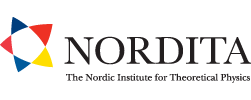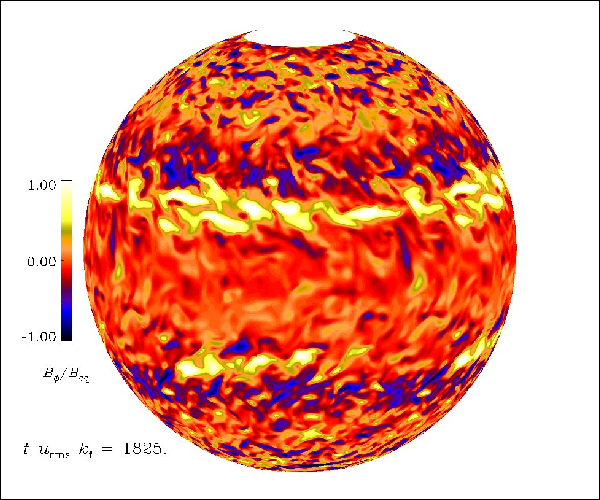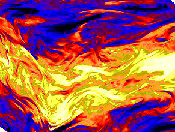

The European Research Council decided in 2008 to fund a concentrated 5-year effort at Nordita in Stockholm to improve our understanding of astrophysical dynamos. This work couples large-scale numerical simulations with numerically guided analytical approaches. An ultimate goal is to have a physically consistent model of the solar dynamo.
Simulations, on the one hand, still lack some potentially important properties (tachocline, near-surface shear layer, ability to shed small-scale magnetic helicity), while analytic approaches (including mean-field theory) are still being developed to explain and reproduce more successfully some of the systematic behaviors seen in simulations.

One of the default research tool is the Pencil Code, which is a public domain code initiated at Nordita and used for solving partial differential equations on massively parallel computers. It is now hosted by Github. Its maintenance through a remote versioning system allows the users easy updates and the possibility of sharing new and/or experimental developments with other users.
News- 16 Dec 2022: Yutong He defends his Licentiate on Gravitational Waves from Primordial Magnetic Sources
- 23 June 2022: Beatriz Villarroel, the first Swede ever, receives the L'Oréal-Unesco International Rising Talent award for Women in Science
- 12 October 2021: Relic Gravitational Waves from Inflationary Magnetogenesis with the Pencil Code, also with helicity
- 8 March 2021: Beatriz Villarroel receives the L'Oréal-Unesco For Women in Science-prisets
- 27 November 2020: first meeting of the new composition of the Pencil Code Steering Cttee (minutes)
- 18 September 2020: Pencil Code Collaboration paper now in review in JOSS
- 1 August 2020: obituary appeared for David Moss (1943-2020)
- 17 July 2020: first issue of the Pencil Code Newsletter has appeared
- 20 March 2020: Virtual Nordic Dynamo Lecture Series (https://stockholmuniversity.zoom.us/j/940229961)
- 9 February 2020: Karl-Heinz Rädler (1935-2020)
- 30 January 2020: Gene Parker receives the Crafoord Prize
- 2 January 2020: Ed Spiegel (1932-2020)
- 2 December 2019: PhD position: https://jobregister.aas.org/ad/a2338b48
- 22 November 2019: PhD position in gravitational waves
- 2 October 2019: Special issue on Physics and Algorithms of the Pencil Code now complete
- 12 June 2019: Julia Asplund finds No sign of left-handedness in GeV photon arrival directions
- 1-5 Apr 2019: Turbulence & magnetic fields - from the early universe to late-type stars
- 8 Jan 2019: Illa R. Losada defends her thesis on the Formation of solar bipolar regions
- 21 Sep 2018: Xiang-Yu defends his thesis
- 31 Aug 2018: Xiang-Yu's thesis on DIVA: Droplet growth in atmospheric turbulence: A direct numerical simulation study
- 2 Jun 2018: Pencil Code developer Andreas Schreiber defended diffusion-limited planetesimal formation
- 12 Dec 2017: three open postdoc positions at SU solar group
- 22 Nov 2017: Group visitor Miikka Väsälä's PhD thesis successfully defended
- 20 May 2016: Press release: Hidden magnetic field during grand minimum
- 20 May 2016: Sarah Jabbari defends her PhD thesis
- 20 May 2016: Xiang-Yu Li defends his Licentiate thesis
- 16 Mar 2016: Sarah receives an SPD Studentship Award
- 5 Jan 2016: Nishant submitted paper on the solar f-mode precursor
- 16 Aug 2015: Barbara Perri submitted her Internship Report
- 15 May 2015: Fig 5 of Harsha's tidal disruption in NGC 5905 on the cover of Ap. Spa. Sci.
- 18 Apr 2015: The Pencil Code has been successfully migrated from googlecode to Github.
- 11 Apr 2015: Katie's talk about the Dark Side of the Universe
- 22 Mar 2015: Katie Freese in Finnish Gloria magazine
- 27 Feb 2015: new AlbaNova/Nordita/OKC promotional video is out
- 22 Jan 2015: XMM time to Harsha Raichur for intermediate mass black holes
- 5 Dec 2014: Illa R. Losada defended successfully her licentiate thesis
- 2 Oct 2014: KAW Grant "Bottlenecks for particle growth in turbulence" to B. Mehlig et al.
- 19 May 2014: Sarah Jabbari defended successfully her licentiate thesis.
- 11 Apr 2014: Astrofysikern Axel Brandenburg ny ledamot i akademien
- 2 Apr 2014: PhD position in particle clustering and rain drop formation (Stockholm U & Nordita)
- 1 Mar 2014: launch of TurboPart on particle clustering in stratified turbulence)
- 13 Dec 2013: Grant on particle clustering for Nordita (FRINATEK, Norway)
- 2 Dec 2013: Research Video: Solar Physics at Nordita
- 25 Sep 2013: K-H Rädler receives the Schwarzschild Medal
- 5 Aug 2013: Bipolar region from NEMPI
- 12 Jul 2013: Anders Johansen receives the Harold C. Urey prize
- 24 Jun 2013: NEMPI with vertical field: just submitted
- 31 May 2013: Warnecke's PhD defense, additional photos
- 29 May 2013: Atefeh Barekat defends her Master's thesis
- 8 May 2013: Warnecke's PhD thesis on DIVA
- 30 Apr 2013: Ebru Devlen receives the Astronomy Science Award of Turkey
- 8 Apr 2013: Start of program on Differential Rotation etc
- 30 Jan 2013: popast.nu about NEMPI
- 19 Jan 2013: Final report about Winter School put online
- 17 Dec 2012: Decision to host the Solar Physics Institute at Stockholm University
- 7 Dec 2012: Simon Candelaresi defends his thesis
- 30 Nov 2012: Nordita movie released
- 14 Nov 2012: Fabio Del Sordo defends his thesis
- 7 Nov 2012: Shibata-san and Axel, now and then
- 26 Oct 2012: Koen Kemel defends his thesis
- 8 Oct 2012: Sabine Hossenfelder publishes blog entry about the Sun's butterfly diagram
- 28 Jul 2012: equatorward migration in solar dynamo model just published
- 1 Jul 2012: dynamos in SNR shocks; see our paper onthe Bell instability
- 21 May 2012: equatorward migration in spherical wedge convection
- 26 Mar 2012: Jörn's home page released
- 21 Mar 2012: Equinox BBQ
- 12 Feb 2012: NEMPI page moved to here (with new convergence plot)
- 26 Nov 2011: MHD course schedule annouced (starting 17 Jan 2012)
- 18 Nov 2011: PhD studentship 2012 annouced (deadline 15 Jan 2012)
- 8 Nov 2011: Tage Erlander Guest Professorship to John Wettlaufer
- 3 Oct 2011: publication of Detection of NEMPI in DNS in ApJL 740, L50
- 18 Sep 2011: Chi-kwan Chan has his sg2 code on GoogleCode
- 16 Aug 2011: Koen Kemel defends his licentiate thesis
- 6 May 2011: Jörn Warnecke defends his licentiate thesis
- 11 Feb 2011: Simon Candelaresi defends his licentiate thesis
- 9 Feb 2011: Fabio del Sordo defends his licentiate thesis
- Internship student:-
- Master student: Patrik Tengner (2022-),
- PhD students: Yutong He (2020-),
- Post-docs: Beatriz Villarroel (2018-), Ramkishor Sharma (2021-),
- Nordita fellows: (2021-), Sambit Giri (2022-),
- Assistant professors: Dhrubaditya Mitra (2010-), Lars Mattsson (2015-),
- Visiting professors: Bengt Gustafsson (2010-), Maarit Käpylä (2020-). Michael Liberman (2013-).
- PI: Axel Brandenburg, his research highlights and publications.
 Former Members
Former Members - em>Internship student: Violaine Auger (2009), Emeric Bron (2010), Barbara Perri (2015), Lina Issa (2020), Patrik Jakab (2020).
- Master students: Atefeh Barekat (2012-2013, now at MPS).
- PhD students: Koen Kemel (2009-2012, now at Leuven), Simon Candelaresi (2009-2013, now at Dundee), Fabio Del Sordo (2009-2013, now at Yale), Jörn Warnecke (2009-2013, now at MPS). Sarah Jabbari (2012-2016) , Illa R. Losada (2013-2019, now at the McDonald Observatory of the University of Texas at Austin), Xiang-Yu Li (2014-2018, now at Pacific Northwest National Lab, Richland, WA 99354, USA). Vipin Agrawal (2017-2022),
- Post-docs: Piyali Chatterjee (2009-2011), Gustavo Guerrero (2009-2011), Alexander Hubbard (2008-2011). Nishant Singh (2013-2016), Harsha Raichur (2015-2016), Akshay Bhatnagar (2016-2020), Andrea Bracco (2017-2018), Xiang-Yu Li (2019-2020), Camilia Demidem (2019-2021), Hongzhe Zhou (2020-2022), Patryk Pjanka (2020-2022),
- Nordita fellows: Niccolò Bucciantini (2009-2011), Chi-kwan Chan (2010-2012), Oliver Gressel (2012-2013). Mikhail Modestov (2012-2014), C. Anthony van Eysden (2012-2014), Bidya Binay Karak (2013-2015), Lars Mattsson (2013-2015). Jennifer Schober (2015-2017), Alexandra Veledina (2016-2017). Livia Vallini (2016-2018), Joonas Nättilä (2018-2020), Upasana Das (2018-2020), Mattia Bulla (2019-2021),
- Researchers: Christer Sandin (2020), Nils E. L. Haugen (2020).
- Assistant professor: Petri Käpylä (2009-2011, but on leave), Lars Mattsson (2015-2021), Alexandra Veledina (2017-2022), Gudlaugur Johannesson (2017-2022).
- Visiting fellows: Hans-Erik Sätherblom (2011-2013), Ahmet Devlen (2013), Ebru Devlen (2012-2013).
- Vising professors: Matthias Rheinhardt (2009-2011 and 2013-2014), Leonid Kitchatinov (2011), John Wettlaufer (2011-2012), Gunnlaugur Björnsson (2012). Juri Poutanen (2016-2021).
- Nathan Kleeorin (2010-), Karl-Heinz Rädler (2008-2015), Igor Rogachevskii (2010-).

The Nordita Astrophysics Group in June 2015.
From the left, starting from the back: Igor Rogachevskii, Nishant Singh, Nils Erland Haugen, Xiang-Yu Li,
front row: Axel Brandenburg, Barbara Perri, Sarah Jabbari, Harsha Raichur, Dhrubaditya Mitra, Bidya Binay Karak.
Events
- 27 Aug - 20 Sep 2019 Gravitational Waves from the Early Universe (Stockholm)
- 1-31 March 2019 Solar Helicities in Theory and Observations (Stockholm)
- 15 June - 10 July 2015 Origin, Evolution, and Signatures of Cosmological Magnetic Fields (Stockholm)
- 9 - 13 March 2015 Sunspot formation: theory, simulations and observation (Stockholm)
- 23 - 27 Sep 2013 Galactic Magnetism in the Era of LOFAR and SKA
- 8 Apr - 3 May 2013 Differential Rotation and Magnetism across the HR Diagram
- 7 - 18 January 2013 Nordita Winter School 2013 in High-Energy Astrophysics
- 15-17 Oct 2012 12th European Workshop on Astrobiology
- 6-10 August 2012 Astrophysics Code Comparison Workshop
- 17-21 Oct 2011 The solar course, the chemic force, and the speeding change of water
- 25 Jul - 19 Aug 2011 Dynamo, Dynamical Systems and Topology
- 26 Apr - 27 May 2011 Predictability + School on Data Assimilation
- 14 - 18 Feb 2011 RädlerFest: α effect and beyond
- 11 - 22 Jan 2010 Winter School on Astrophysical Dynamos
- 25 Sep - 25 Oct 2009 Solar and stellar dynamos and cycles
- 6 - 10 Apr 2009 Astrophysical Magnetohydrodynamics
- 17 Mar - 11 Apr 2008 Turbulence and Dynamos
Links
- Skyddsombud: Anthony Bonfils (Nordita), and Habib Rostami (Nordita), Lisbeth Häggberg (SU)
- Project pages: daily routine and progress reports
- Press release of 15 Sept 2008, ERC overall outcome
- Interview with British Publishers, January 2010
- Report after 18 months, September 2010
- Report after 30 months, October 2011
- Report after 36 months, March 2012
- Report after 54 months, September 2013
- Report after 60 months, February 2014
- Nordita Astrophysics in 2010, December 2010
- Nordita Astrophysics in 2013, September 2013
- How to find Nordita on Google Earth
Try to scan the box on the right with your Android barcode scanner! (Download barcode scanner from the Android Marketplace. For iPhone and Blackberry and others: Neo Reader)
View Larger Map, near Valhallavägen.
Figure at the top: courtesy of Dr Petri Käpylä
Käpylä, P. J., Mantere, M. J., & Brandenburg, A.: 2012, ``Cyclic magnetic activity due to turbulent convection in spherical wedge geometry,'' Astrophys. J. Lett. 755, L22 (arXiv:1205.4719, ADS, DOI, PDF)